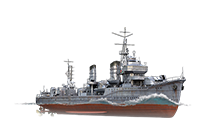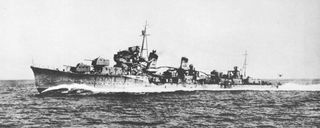PJSD006 Hatsuharu 1945
| kt Max Speed |
| s Rudder Shift Time |
| m Turn Radius |
| - mm Hull Armor |
| - mm Citadel Armor |
| - mm Deck Armor |
| - mm Extremities Armor |
| Guns |
| Guns |
| Torpedoes |
| Recon Squadrons |
| km Aerial Detection Range |
| km Surface Detection Range |
A project designed in line with the limitations of the London Naval Treaty of 1930. The attempts of the shipbuilders to equip the new class with the armament of larger destroyers despite the limited displacement resulted in weight and stability problems. The project was redesigned, and the first two completed ships of the class underwent modernizations. A total of six destroyers were built. Ships of this class became the first to be equipped with the 610 mm oxygen torpedoes. All destroyers were lost during the Pacific War between 1942 and 1945.
The Hatsuharu-class Destroyer is a Tier 7 ship in the Japanese destroyer Tech Tree.
This ship leads to the Fubuki-class Destroyer.
Modules
Compatible Equipment
Historical Info
The weight of the hull could generally be reduced by using higher grades of steel that were lighter and smaller for the same strength, reducing dimensions, particularly length, or using advanced construction techniques like welding that saved weight over the conventional riveting. The Japanese used the same high tensile steel for the Hatsuharu class as they did for the older destroyers and chose not to increase the power of the turbines and boilers to achieve the desired high speed, but lengthened the hull to offset the reduced power of the light-weight machinery. The beam was increased to counter some of the extra top-weight, but the draft was reduced to reduce hull resistance, which also reduced stability by lessening the area of the hull beneath the waterline in comparison to the area above it, which was subject to pressure from the wind. Electric welding was extensively used to reduce weight although it was at an early stage of development in Japan and was still problematic.
Extensive weight-saving measures were used during the design and construction of the hull. More frames of lighter construction were spaced more closely together to reduce the thickness of the hull plating and the extensive use of welding (only the longitudinal strength members and a few other parts were riveted) were some of the techniques utilized to reduce hull weight by 66.5 tonnes (65.4 long tons; 73.3 short tons) in comparison to the Fubuki class. The Hatsuharu vessels were some 10 metres (32 ft 10 in) shorter than the Fubuki class vessels, but weighed 4.9 tonnes (4.8 long tons; 5.4 short tons) per 1 metre (3.3 ft) of hull length compared to the latter's 5.09 tonnes (5.01 long tons; 5.61 short tons) per 1 metre (3.3 ft).
The Hatsuharu-class ships were shorter than their predecessors, at 109.5 m (359 ft 3 in) overall. The ships had a beam of 10 metres and at full load a draft of 3.35 m (11 ft 0 in). Despite the emphasis on weight-saving during construction, the ships were significantly overweight as completed and displaced 1,530 metric tons (1,510 long tons) at standard load, and 1,981 metric tons (1,950 long tons) at full load, nearly 130 metric tons (100 long tons) more than planned.
The hull of the Hatsuharu-class vessels retained the general configuration of the Fubuki-class destroyers with a long forecastle and a pronounced flare of the forecastle to improve sea-keeping at high speeds by adding buoyancy and reducing the spray and water coming over the deck. A large bridge structure was located at the aft end of the forecastle deck topped by four fire control stations of various types. Lowest, just above the compass bridge, was the torpedo director (Hassha shikisho), with the gunnery fire direction station (Shageki shikisho) next above. The fire director tower (Hōiban shagekito) was third from the bottom and behind it was the 3 m (9 ft 10 in) rangefinder. Each of these was protected by 10 mm (0.39 in) plates of Dücol steel against strafing and shell splinters.
For the first time in a Japanese destroyer a superfiring turret was fitted forward of the bridge. It was only a single gun Model A turret, to save weight high in the ship, and was mounted on a deckhouse to elevate it above the twin gun Model B Mod 2 (B-gata kai-2) turret mounted on the forecastle deck. The second twin gun turret was mounted at the rear of the ship on the main deck. These turrets were slightly heavier than the earlier Model A and Model B turrets fitted on the Fubukis. All turrets were fitted with the 12.7 cm (5.0 in) Type 3 gun.
The uptakes of the two forward boiler rooms were trunked together aft of the break in the forecastle into the fore funnel while the rear boiler room exhausted into the smaller rear funnel. Both funnels were inclined to the rear to reduce the amount of smoke that might reach the bridge. A tripod mast was fitted between the bridge and the fore funnel. Between the two funnels was the forward 61 centimetres (24 in) triple torpedo tube mount fitted on a low platform. Behind it "was a torpedo locker with its mechanical quick reload system (Kiryoku sōtenshiki jihatsu sōten sochi) for the three reserve torpedoes inside."[7] To preserve lateral stability the aft funnel was offset to starboard while the torpedo mount was offset to port. The reload locker was also offset slightly to port and angled inboard to facilitate reloading. The middle torpedo mount was positioned behind the aft funnel on the centerline, but its reload locker was positioned identically to that of the forward mount. Superimposed to starboard and overlapping the middle mount was the rear triple torpedo mount positioned on the rear deckhouse. Immediately behind the mount was its locker positioned on the centerline, but angled slightly to the right so that its mount only had to traverse slightly to align with the locker and begin reloading. This was the first ship in history to be fitted with superimposed torpedo tubes, made necessary by the designer's insistence on fitting nine torpedo tubes despite the Navy's requirement for only six.
A small platform that carried a 2 m (6 ft 7 in) rangefinder was mounted above the rear torpedo locker and a 90 cm (2 ft 11 in) searchlight was mounted on a tower behind the rear funnel. The two license-built Vickers 40 mm (1.6 in) (pom pom) anti-aircraft guns were mounted on an elevated platform at the front of the rear funnel. Curiously they were another case where the designer exceeded the requirements laid down by the Navy.
General Characteristics:
Type: Destroyer
Displacement: 1,530 t (1,510 long tons)
Length: 109.5 m (359 ft 3 in) overall
Beam: 10 m (32 ft 10 in)
Draught: 3.38 m (11 ft 1 in)
Installed power: 42,000 shp (31,000 kW)3 water-tube boilers
Propulsion: 2 shafts; 2 Kampon steam turbines
Speed: 36 knots (67 km/h; 41 mph)
Range: 4,000 nmi (7,400 km; 4,600 mi) @ 14 knots (26 km/h; 16 mph)
Complement: 212
Armament:
- 2 × twin, 1 × single Type 3 127 mm 50 caliber naval guns
- 2 × single 40 mm AA guns
- 3 × triple 610 mm (24 in) torpedo tubes
- 18 × depth charges
Historical Gallery
Sources and External Links
| Destroyers | |
| Cruisers | |
| Battleship | |
| Aircraft Carriers |
| USA | |
| UK | |
| USSR | |
| Japan |

